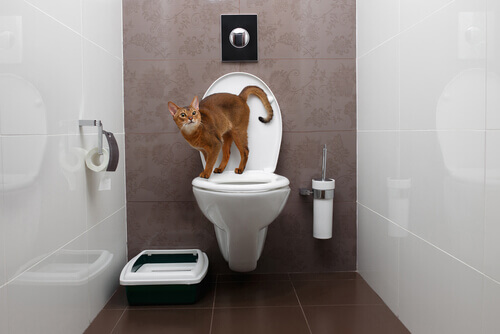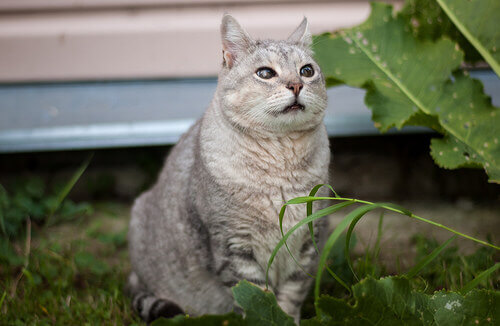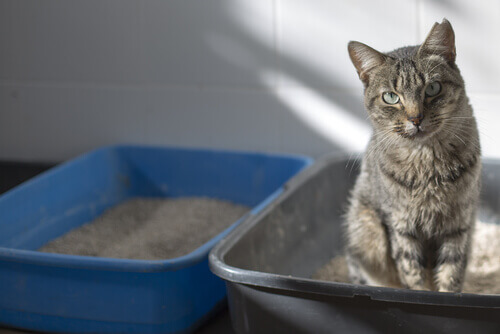Incontinence in Cats: What You Need to Know

Cats are among the cleanest pets. They’re extremely concerned about their grooming and are very diligent. Incontinence in cats is a reflection of a health problem where emotional or physical discomfort causes involuntary urine loss.
If you detect that a feline has made changes in its urination, then you should visit a veterinarian. It’s not worth scolding or punishing your pet, since it’s a situation that they can’t control. In fact, without a doubt, the cat itself also feels just as annoyed and uncomfortable with the situation as you do…if not more.
Incontinence in cats is the inability to control its sphincters. While it’s more common in older cats, it can happen to felines of all ages. It’s crucial to identify the causes of the disease in order to provide appropriate treatment.

Causes of incontinence in cats
- Age. Older cats often begin to experience incontinence because their tissues weaken with age.
- Congenital malformation. If there are deformities in their bladder or urethra, they may not have full control of their sphincters. In these cases, the disease begins to manifest itself in the first months of life.
- Urinary infection. They need to go to their litter box all the time and nothing comes out. Then, when they need to go, they don’t make it to the box on time.
- Sterilization. This process suppresses a series of hormones in the animal. The absence of these can cause incontinence in cats.
- Being overweight: This also has a negative influence.
- Feline leukemia. They tend not to control their urethra, especially while they’re asleep.
- Feline cancer. The pressure that certain tumors exert in their bodies causes incontinence.
- Stones. Small stones formed by minerals obstruct the urethra; they also produce an inflammation of the bladder. This partially blocks the urine outlet, causing incontinence.
- Trauma to the pelvis, hips or spine. The blows that some felines have suffered in accidents can affect the control of urine.
- Emotional disorders. Changes in environment due to a move or a new family member also affect cats. If the problem’s emotional, then the owner should give their pet more attention. Similarly, if incontinence persists, it’s important to seek professional help.
What owners should do about incontinence in cats
Your pet’s going through a stage that may be more or less easy to overcome. The main thing that owners need to know is that they shouldn’t scold or punish their cats if they become incontinent. Your frustration could make the situation worse.
What animals need is a lot of patience, love, and companionship like any other sick person. They need to know that you care about them and that they’ll be able to reverse the situation. Placing more litter boxes throughout the house is a good way to start.

Incontinence causes skin irritations in cats, so it’s important to prevent these situations, and increase check-ups. Every time you find your pets wet with their own urine, you need to wash and dry them.
Besides the emotional support you provide to your cat, you should also see a veterinarian in order to obtain a diagnosis. Detecting the true cause of incontinence in cats opens the door to finding the appropriate treatment.
Treatments for incontinence in cats
The treatment of incontinence in cats will depend on the cause. In most cases, treatment brings good results. However, it’s important not to let too much time go by before asking for help. Some possible treatment options are:
- Hormonal supplements. The professional will usually apply this treatment in the case of neutered cats.
- Antibiotics. Regularly taking medication eliminates urinary tract infections, and can also control other diseases that cause incontinence.
- Catheter. In the most severe cases, a permanent catheter may be necessary to drain their urine.
- Surgery. This is necessary to correct some deformities in the bladder or urethra. Similarly, when there are stones that don’t go away with previous treatments.
- Diet. Experts recommend a low-fat diet for overweight cats. It’s difficult to change their eating habits, but it’ll help them to have a healthier and more hygienic life.
- Collagen injections. A new therapy gives several collagen injections at the same time to strengthen the muscles that control the urethra.
There are no preventive measures for incontinence in cats; it’s simply a matter of keeping an eye on their health. When faced with an unusual symptom, you need to be patient and call a professional.
